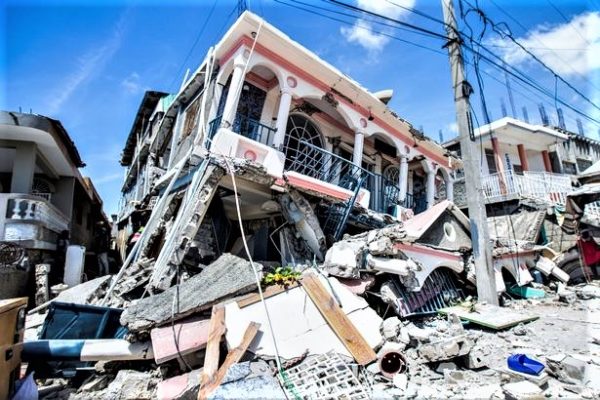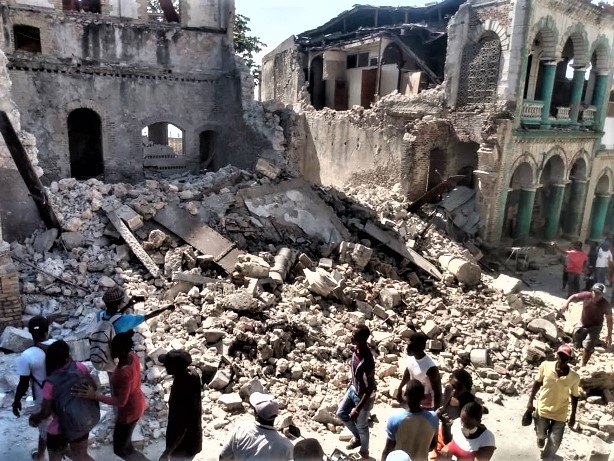
The photo above is from Les Cayes; the photo below is from Jeremie:

Please understand, these are places that several of us have visited and walked along these streets, and where we have many Haitian Christian brothers and sisters who we know and love.
In addition to what I reported yesterday (see https://thehaitifund.org/2021/08/14/7-2-magnitude-earthquake-hits-haiti/), here’s what I know right now:
From the NY Times:
Haitians struggled with a lack of basic supplies, including food and medical care, in the aftermath of a magnitude 7.2 earthquake on Saturday that snapped water lines, blocked roads, flattened grocery stores and damaged hospitals on the country’s southwestern peninsula.
The powerful earthquake was a devastating blow to a country that is still reeling from a presidential assassination last month and that never recovered from a disastrous quake more than 11 years ago. Aid groups and government rescue workers established a single operation center in Port-au-Prince to coordinate the quake response, but many in the hard hit town of Les Cayes were loading the injured into cars and onto private planes to try to evacuate them to the capital, Port-au-Prince, for care.
Herve Foucand, a former senator, was using his small propeller plane to ferry people to Haiti’s capital.
“I have 30 people in serious condition waiting for me,” he said. “But I only have seven seats.”
Small towns surrounding Les Cayes were cut off by landslides and are believed to be even harder hit.
To complicate the chaotic efforts even more, Tropical Storm Grace was expected to pass over Haiti on Monday, although forecasters said it might spare the peninsula hardest hit by the quake.
The confirmed death toll rose to 724 on Sunday and at least 2,800 people have been injured, Jerry Chandler, head of Haiti’s Civil Protection Agency, said at a news conference.
Mr. Chandler said that heavy damage had been reported in the cities of Jérémie and Les Cayes, an area that is less densely populated but also more remote. Thousands of homes and a multistory hotel collapsed, and some roads and bridges were impassable, complicating rescue and aid efforts. Still, Mr. Chandler promised a “more appropriate response than the one we gave in 2010,” when millions in aid seemed to vanish amid a cloud of corruption and confusion.
The full extent of the damage and casualties is not yet known. But doctors said hospitals were overwhelmed.
A building housing medical students, hospital interns and two doctors had collapsed, trapping those who were most needed to provide aid, said Dr. James Pierre, a surgeon at the general hospital of Les Cayes, also known as the Hospital Immaculée Conception.
A day after a magnitude 7.2 earthquake ripped through western Haiti — killing 724 people — the main airport of the city of Les Cayes was overwhelmed with Haitians trying to evacuate their loved ones to the capital, Port-au-Prince. The needs of the wounded were too huge for local hospitals and doctors to handle.
Officials in Les Cayes believe there are no more than 30 doctors in the entire southern region, home to roughly one million people. All the main hospitals are damaged. Doctors in Les Cayes worked overnight to build a temporary operating room — made of corrugated tin — near the airport.
An orthopedic surgeon, Edward Destine, was tending to the injured there. “I’m the only surgeon,” he said.
“I would like to operate on 10 people today, but I just don’t have the supplies,” he added, saying he needed intravenous drips and antibiotics.
Many of the wounds were fractures, Dr. Destine said, including dangerous head and femur fractures.
Because the wounds were open and many people were living in damaged homes or out on the streets, he expected thousands to suffer from potentially fatal infections.
“We can’t even do lab tests or xrays,” he added.
Palmera Claudius, 30, lay in the bed of a pickup truck her relatives had hired to take her to the airport. The left side of her face was swollen, and her left arm was in a makeshift sling made from a torn blue shirt.
She was in her family home in Camp Perrine, on the outskirts of Les Cayes, when she felt her whole house jolt on Saturday. As she tried to run outside for safety, a wall collapsed on her.
She cannot feel her legs, she said. The local clinic in her town does not have the capacity to X-ray her. She was hoping to catch a flight to the capital as soon as one was available and willing to take her for free. Her family has no money to pay the cost.
The nephew of Ilda Pierre had just discovered her body among the pews of St. Agnes church when an aftershock ripped through the mountainous town, rattling the collapsed corrugated tin roofs strewn across the dirt.
Honore Faiyther closed his eyes and waited for the trembling to pass as he sat on what had once been the wall of the church — now just a slab of cement. Steps away from him, the body of Ms. Pierre lay on a metal grate, a white sheet covering her body.
Ms. Pierre had been cleaning the church with a friend when an earthquake of magnitude 7.2 struck Saturday. As they tried to run outside, a pillar collapsed just as Ms. Pierre’s friend reached the door, smacking her in the head and crushing her skull. She was killed instantly.
It’s not clear if Ms. Pierre was also killed immediately. Mr. Faiyther and three friends had been searching for her since midmorning Saturday and only discovered her bruised and bloodied body Sunday afternoon when people in the neighborhood had joined together to wrench open the roof that had collapsed on the church, sealing the wreckage underneath.
“My aunt has four children, and she’s very active in our community and volunteered in this church for five years,” said Mr. Faiyther. “Her husband is in denial — he cannot face that she is dead.”
Father Jean Edy Desravines described the moments after the earthquake, as cries pierced the mountain range and people searched for their loved ones.
“I was preparing a sermon for today, to inspire parents to send their children back to school next month, to have them rejoin our community after such a tough year,” said Father Desravines, referring to the coronavirus pandemic.
“Now there is no school to even send them to,” the priest said, adding that the primary school his church runs had also been flattened by the quake.
More than 24 hours after the quake, no government help had arrived.
Later that night, he said, he would be sleeping in his pickup truck. With no running water, he feared the situation would further deteriorate and disease could become a problem.
The road from Les Cayes, on the coast, to Maceline, in the mountains that overlook the city, was cracked down the center, with boulders and tree branches blocking it.
Families from Les Cayes to Maceline, about 25 kilometers away, are sleeping out in the open, their homes severely damaged or completely destroyed. Many said they were too nervous about the aftershocks to comfortably take shelter under a roof.
The mayor of Maceline, Fenicile Marssius, whose home was destroyed, walked up to the church to check in on Father Desravines.
“This is a catastrophe. We have had no assistance from the government. Maybe they have so much to do in the cities that they cannot reach us in these remote areas,” said Ms. Marssius.
“We believe a lot of people still are underneath the rubble, and many houses and churches have collapsed.”
From The Guardian:
Winnie Hugot Gabriel was presenting her Saturday morning radio show when a 7.2-magnitude earthquake ripped through southern Haiti, sending terrified listeners racing into the streets.
“Even here in Port-au-Prince you could feel it. It was strong,” said the 32-year-old journalist from the Magik 9 station, who abandoned her microphone and sprinted outside after the tremor.
On Sunday as rescue workers searched collapsed buildings for survivors, and aid workers raced to provide food, water and shelter to those forced from their crumpled homes, many of the region’s hospitals were swamped with seriously wounded patients.
“Right now I’m walking around the city to see if we can rescue more people and find more dead bodies,” said Claude Harry Milord, the mayor of Jérémie, where at least 100 fatalities have been confirmed.
Milord said some of the injured were being airlifted to Port-au-Prince. Those who remained were in desperate need of aid. “The city needs medicine, tents and food because many people have lost everything,” he said.
Across the peninsula in Les Cayes, the situation appeared to be even worse. “There are many people injured. The hospitals are overwhelmed. Some are treating people on the floor; some are just sending people back home,” said Akim Kikonda, an aid worker from the group Catholic Relief Services, adding that powerful aftershocks had left homeless survivors on edge. “People are really scared.”
Roody Bouilly, a telecoms worker in Les Cayes, said schools, hotels and supermarkets had been levelled. “What happened was really painful,” the 40-year-old said. “The city is really panicked. Last night lots of people slept on the streets, almost like we saw in Port-au-Prince on 12 January 2010.”
Complicating rescue efforts was the fact that the only road linking Haiti’s capital with the three worst-hit departments – Grand ’Anse, Nippes and Sud – has become virtually unpassable in recent months because of a deadly struggle between police and heavily armed criminal gangs.
“It has been a war zone for a long time. Fuel cannot get through. Supplies cannot get through. Ambulances cannot get through,” said Jean William Pape, a prominent Haitian doctor who, because of the gangland conflict, was using helicopters and small planes to ferry supplies to hospitals in Jérémie and Les Cayes.
Milord, Jérémie’s mayor, said he feared that the arrival of tropical storm Grace, which is due to hit Haiti on Monday or Tuesday, would further complicate relief efforts. “I really don’t know what might happen,” he said, remembering how he had seen bodies strewn on the streets of his city after the quake struck at about 8.30am on Saturday.